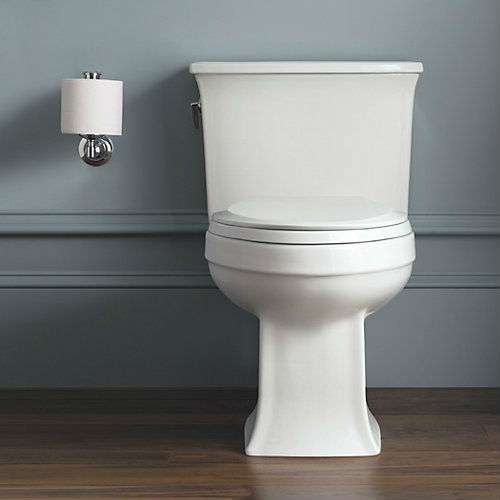As more and more manufacturers and homeowners have taken steps to become more eco-friendly, the prevalence of dual-flush toilets has risen. Yet there are still plenty of benefits to the more traditional single-flush toilet. Before you write off the single-flush option for good, check out the advantages and disadvantages and how they relate to your situation.
A Look From the Inside Out
A single-flush toilet might not look too exciting, and that’s because it’s probably the type of toilet that you’ve always had in your home. The single-flush toilet is a conventional type of toilet found in many homes, making it a familiar and straightforward bathroom fixture.
This toilet gets its name from its one-flush mechanism. This is usually apparent by the traditional-looking flusher that sits on the front or side of the tank. Besides that, a single-flush toilet may have a round or elongated bowl, and it may have concealed or exposed trapways.
From an aesthetic point of view, there isn’t much of a difference between single and dual-flush toilets. The primary difference is that the single-flush design has a flusher handle that can be changed to suit your style preferences. The button on a dual-flush toilet is pretty much the same on all models.
With a single-flush design, every type of waste is flushed with the same force and amount of water. As you’ll see, this differs from the dual-flush design.
The Competition of Dual-Flush Toilets
The emergence of dual-flush toilets is giving the single-flush design a run for its money. What’s so great about dual-flush toilets? This type of toilet can help you conserve more water since you’re choosing how much to use for each flush. After all, why use a few gallons of water when as little as 0.8 gallons will do?
Dual-flush toilets might look strange at first since they don’t have the traditional flush handle on the side. Rather, they have a two-push button that typically sits on the top of the tank. One button will get rid of waste with just a small amount of water while the other button is for waste that requires more water. In most models, the quantities of water used can range from 0.8 to 1.6 gallons.
Making the Best Decision for Your Home
First, you may want to read our in depth reviews of single flush toilets. This might have homeowners wondering if they should go with a dual-flush toilet instead of the old single-flush model. Before you commit, consider the pros and cons of each option.
When it comes to single-flush toilets, it is easier to find replacement parts since they’ve been the norm for so long. Some manufacturers haven’t fully caught up with the dual-flush trend yet, so it can be more difficult to repair these types of toilets.
Also, single-flush toilets tend to be easier to fix, particularly in the case of tank issues. The internal components are more straightforward, so this could mean a smaller repair bill for your single-flush model. So overall, the maintenance and upkeep of a single-flush toilet is going to be less expensive than a dual-flush one.
Now, if you are greatly concerned about the environment and your water usage, then it makes sense for you to opt for a dual-flush toilet. This can result in a less costly water bill, as well as the peace of mind knowing that you’re being a more conscious consumer.
On the one hand, a dual-flush toilet may come with hidden expenses since they’re a bit trickier to repair. On the other hand, choosing the more environmentally-friendly option may mean a lot to you and your family, and so dual-flush is the way to go.
Speaking from an aesthetic perspective, you won’t see a whole lot of variety between the look of a single-flush and a dual-flush toilet. Again, the big difference is that the dual-flush design doesn’t have a flusher handle, but instead it has a flush button.
One last thing to be aware of is that the flush button on a dual-flush toilet can be a bit more difficult to press for those with injuries or disabilities. A flusher handle tends to push down much more easily. It’s just something to keep in mind if that’s a concern that is relevant to your family.

